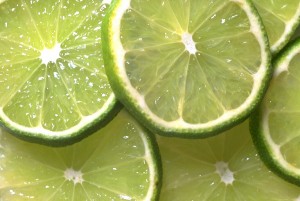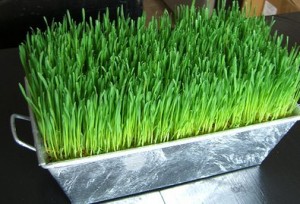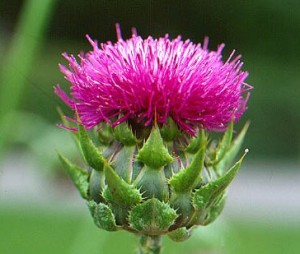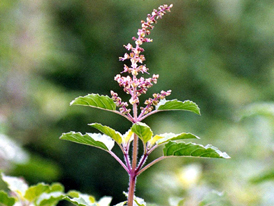Spring Wellness Tips: Teas, Herbs & Supplements For Optimal Health
 Spring, while glorious in so many ways, can be a reminder of just how much we’ve neglected our healthful ways during our winter hibernation. The natural inclination to eat for warmth and low activity can take its toll. Spring blooms are for some people pure misery in the form of seasonal allergies and hay fevers. Spring wellness tips, then, are pretty straightforward: cleanse and strengthen the blood, fight allergies (decrease inflammation), detox and strengthen the liver.
Spring, while glorious in so many ways, can be a reminder of just how much we’ve neglected our healthful ways during our winter hibernation. The natural inclination to eat for warmth and low activity can take its toll. Spring blooms are for some people pure misery in the form of seasonal allergies and hay fevers. Spring wellness tips, then, are pretty straightforward: cleanse and strengthen the blood, fight allergies (decrease inflammation), detox and strengthen the liver.
I have included a list of my top choices that should have something for everyone on it. Some on the list can be taken at the onset of acute symptoms; others require a bit of pre-meditation and some daily usage for a period of time to realize their efficacy. Of course, creating daily health habits with the supplements of your choice year round is always the better scenario. But taken seasonally, these should do the trick:
Magnesium Research has found that this mineral relaxes airways, which helps ease congestion. 200 – 400 mg. daily is recommended for maximum benefit. It is naturally found in highest quantities in bran, spinach, nuts, and bananas.
 Limes have a very high amount of bioflavinoids – which are natural antihistamines that can help relieve allergy symptoms. Limes have more bioflavinoids than any other citrus fruit. Squeeze the juice of half a lime into each glass of water you drink during the course of a day.
Limes have a very high amount of bioflavinoids – which are natural antihistamines that can help relieve allergy symptoms. Limes have more bioflavinoids than any other citrus fruit. Squeeze the juice of half a lime into each glass of water you drink during the course of a day.
Quercitin An antioxidant in the bioflavonoid family found naturally in black tea and several other common foods, quercetin appears to fight inflammation and act as a natural antihistamine. It is recommended to start a quercitin supplement two to three weeks before allergy season to build up nutrient levels in the body. Generally, 1000 mg daily is recommended for mild to average allergies, more if they are severe or acute. At the same time, upping your consumption of foods that are high in quercitin is also good support. These include black tea, citrus fruits, apples, and red onions.
It should be noted that quercetin appears to be more effective when combined with bromelain. Bromelain, a mixture of enzymes found naturally in pineapples, seems to increase the intestine’s absorption of quercetin. 300mg is usually the recommended dosage of bromelain.
Omega 3s The anti-inflammatory properties of omega-3 fatty acid have been well established. In high doses of 3-5 grams or more a day of the active ingredient EPA and DHA. Because there is a strong inflammatory component in allergies and asthma, the use of fish oil to offset a pulmonary disorder is an excellent choice. It takes anywhere from 3-4 months for the omega-3 fatty acid blood level to be built up, so cultivate diligence and patience. Most nutritionists advise avoiding gel caps, and use only the highest quality liquid bottled form that you can afford, for maximum results and easier absorption. For vegetarians/vegans, chia seeds and hemp seeds (found in the bulk bins of natural grocers or online direct from distributors), offer a plant based alternative source of omega 3s to fish oil. Chia seeds have an incredible amount of omegas available in only one tablespoon.
Chlorella Is a single cell sea algae. It has been used for decades in Japan as nutritional supplement, particularly after World War II to offset the effects of the radiation poisoning from the Hiroshima and Nagasaki atom bombs. It removes heavy metal toxins, and generally aids in the body processing more oxygen. It is a “super supplement”, in that it promotes growth and repair of cellular tissues, and cleanses key elimination systems like the bowel, liver, and blood. It’s also been shown to support elimination of molds in the body.
Chlorella is available in tablets, liquid extracts, and as a powder. Some herbalists recommend 2 to 3 grams per day, though higher doses may be suggested for detoxification purposes. A few people take up to 10 or 15 grams (2 to 3 teaspoons) per day. Chlorella contains high levels of vitamin C and carotenoids, both of which are antioxidants. Broken cell wall chlorella is recommended for better overall efficacy and digestibility.
 Wheatgrass What can I say about wheatgrass that doesn’t feel like over the top hyperbole and cliché? Truthfully, bringing wheatgrass into one’s life regularly, really is one of the most important and regenerative health habits that can be embraced. The first tireless promoter of its benefits, was Dr. Ann Wigmore (The Wheatgrass Book by Dr. Ann Wigmore; Penguin 1985).
Wheatgrass What can I say about wheatgrass that doesn’t feel like over the top hyperbole and cliché? Truthfully, bringing wheatgrass into one’s life regularly, really is one of the most important and regenerative health habits that can be embraced. The first tireless promoter of its benefits, was Dr. Ann Wigmore (The Wheatgrass Book by Dr. Ann Wigmore; Penguin 1985).
She cured herself of cancer, and a lifetime of being sickly and weak. Wheatgrass juicing and cleansing became the centerpiece of her approach to a raw foods lifestyle, pretty much igniting the current craze.
The benefits of wheatgrass include: increases red blood cell count, cleanses the blood, organs and gastrointestinal tract of debris. It stimulates metabolism and bodily enzyme systems in enriching the blood by increasing red blood cell count, and in dilating the blood pathways throughout the body, reducing blood pressure. It’s a powerful detoxifier and liver and blood protector. The enzymes and amino acids found in wheatgrass can protect from carcinogens, and chemically neutralizes environmental pollutants.
Dr. Wigmore emphasizes that to get the most out of wheatgrass, is juiced and consumed within 15 minutes of one another. Investing in a decent juicer and learning to grow your own wheatgrass, is, in my opinion, one of the best uses of your time and money you’ll ever spend. Not that it consumes an inordinate amount of time: it doesn’t! It’s a simple, preventative medicine and a holy health habit that will never stop paying dividends.
 Milk Thistle Milk thistle has been used medicinally for over 2,000 years, most commonly for the treatment of liver and gallbladder disorders. It is actually the most researched and best understood of all the medicinal herbs. In fact, study after study has confirmed the most significant property of milk thistle: namely, the ability to protect and actually rejuvenate the liver. The best proof: people who have accidentally ingested the very fatal death cap mushroom (which poisons by attacking the liver), have been saved by taking milk thistle as an antidote.
Milk Thistle Milk thistle has been used medicinally for over 2,000 years, most commonly for the treatment of liver and gallbladder disorders. It is actually the most researched and best understood of all the medicinal herbs. In fact, study after study has confirmed the most significant property of milk thistle: namely, the ability to protect and actually rejuvenate the liver. The best proof: people who have accidentally ingested the very fatal death cap mushroom (which poisons by attacking the liver), have been saved by taking milk thistle as an antidote.
A flavonoid complex called silymarin can be extracted from the seeds of milk thistle and is believed to be the biologically active component. The terms “milk thistle” and “silymarin” are often used interchangeably. Milk thistle’s silymarin actually helps the liver regenerate itself by stimulating the growth of liver cells to replace the parts of the liver that are damaged. Doses of milk thistle range from 140mg to 300mg taken 2 to 3 times a day. Liquid tincture is generally the preferred form in which to take it. The best milk thistle comes standardized to contain a high percentage of silymarin.
Crysanthemum Tea: The Chinese herb Ju Hua, or Crysanthemum flowers, is a bitter, sweet herb that has an affinity for the liver. This herb is said to calm the liver and resolve toxicity. In TCM (Traditional Chinese Medicine), if you are feeling a bit on edge and hot tempered, crysanthemum tea is prescribed for calming the liver. The active components of chrysanthemum are vitamin C, beta-cartone, calcium, fiber, folacin, iron, magnesium, niacin, potassium and riboflavin. Brewing the flowers requires steeping them in hot water for about five minutes. The aroma is gently floral and the smell is instantly calming. This is the perfect delivery system for the herb, as it creates a “time out” moment, and a chance to re-set our affinities, particular if “our bile is up” and we are holding onto petty anger and annoyances. “Mums” are also very easy to grow in pots, so that you can cultivate your own supply for your tea.
 Ginger Ginger contains high amounts of iron and calcium, in addition to its major constituents – gingerol and paradol. Gingerol is a powerful antioxidant – clearing up the free radicals that can do so much harm within the body – and it is anti-inflammatory. Ginger is also believed to support the production and secretion of bile from the liver and gallbladder. The volatile oils in ginger also stimulate the circulatory and respiratory systems, lower cholesterol, deter blood clots and purify the blood.
Ginger Ginger contains high amounts of iron and calcium, in addition to its major constituents – gingerol and paradol. Gingerol is a powerful antioxidant – clearing up the free radicals that can do so much harm within the body – and it is anti-inflammatory. Ginger is also believed to support the production and secretion of bile from the liver and gallbladder. The volatile oils in ginger also stimulate the circulatory and respiratory systems, lower cholesterol, deter blood clots and purify the blood.
J’adore’ ginger: it’s very versatile and tasty. I prefer fresh, organic ginger to capsules containing the powdered version. The easiest delivery method is to add it to a smoothie. It gives even the most bland concoction a pleasant “kick”. For people who have sluggish circulation, particularly on chilly days, drinking a smoothie with ginger will bring up your internal temperature and give you a much needed “flush”. Having it on hand, like fresh garlic, and regularly adding to your food on an everyday basis is easy: grating an inch long bit into rice, lentils, stir-fry dishes, and even salad dressings, is all you need.
Turmeric is in the rhizome family of roots, and is related to ginger. It is a spice that has been a vital part of Chinese herbal and Ayurvedic Medicine for centuries. It’s what gives curry powder its distinctive golden yellow color, and is also known as Indian saffron. It has traditionally been used for liver ailments and as a digestive aid by traditional herbalists, but has recently become popular in the Western world due to its multiple health benefits from its anti-inflammatory, antioxidant and antibacterial properties. It has a particularly interesting effect on the liver detox pathways. The liver eliminates toxins through the bile that it makes and turmeric helps to increase bile flow. German researchers found that when turmeric was taken with Milk Thistle and Celandine, it increased bile flow about six times more than when the herbs were used without it..
You can add turmeric or curcumin to your diet in capsule form. Curcumin is often found with Bioperine which helps absorption. Look for standardized extracts for the best effects. The usual dose is 500 mg three times a day. There have been warnings about several brands of turmeric containing high lead levels so make sure you buy a reputable brand. Ask for help in the supplement section of your retailer.
 Tulsi (also known as Holy Basil) is used as a blood purifier and to flush out toxins in the Ayurvedic health system. It has a strong aroma and astringent taste, and is regarded in Ayurveda as a kind of “elixir of life”. Tulsi (Sanskrit for “the incomparable one”), has been a sacred plant and worshipped by Hindus for thousands of years. Water mixed with tulsi petals is given to the dying to raise their departing souls to heaven. Many Hindus have tulsi plants growing in front of or near their home, often in special pots. Tulsi is considered to be an adaptogen, balancing different processes in the body, and helpful for adapting to stress. The aroma emanating from tulsi is an intoxicating and refreshing fragrance, and is said to purify the blood from just inhaling the aroma first thing in the morning. Indians traditionally chew on the leaves, but the easiest way for Americans to find and use it is in teas.
Tulsi (also known as Holy Basil) is used as a blood purifier and to flush out toxins in the Ayurvedic health system. It has a strong aroma and astringent taste, and is regarded in Ayurveda as a kind of “elixir of life”. Tulsi (Sanskrit for “the incomparable one”), has been a sacred plant and worshipped by Hindus for thousands of years. Water mixed with tulsi petals is given to the dying to raise their departing souls to heaven. Many Hindus have tulsi plants growing in front of or near their home, often in special pots. Tulsi is considered to be an adaptogen, balancing different processes in the body, and helpful for adapting to stress. The aroma emanating from tulsi is an intoxicating and refreshing fragrance, and is said to purify the blood from just inhaling the aroma first thing in the morning. Indians traditionally chew on the leaves, but the easiest way for Americans to find and use it is in teas.
I have had good success growing tulsi in my garden here in Southern California. It’s pretty hardy and hard to mess up, even if you are a gardening novice. It’s worth trying to grow since it is such an amazing and wonderful plant to have around. Its smell is head turning, and it’s so great to pinch off a leaf and chew on it.
Burdock (Gobo Root): Burdock Root, a native plant of Asia and Europe, contains a number of medicinal properties that have been used for hundreds of years. Traditionally herbalists all over the world use Burdock Root as a blood purifier and to detox the liver, lymph and lungs. It is the root of the Burdock plant that is harvested for medicinal use. It contains an oil that increases perspiration, thus aiding in the elimination of toxins from the body.
Burdock contains inulin, a carbohydrate that strengthens the liver. The tea also has powerful anti-inflammatory activity based on studies and reduces liver damage from toxic chemicals. As a mildly bitter-tasting herb, it increases saliva and bile secretion, which aids digestion and cleanses the liver. Sought after in Japan and cooked in many recipes, as it has a potato-like flavor.
Interesting fact: Burdock tends to stick to the fur of animals, and was the inspiration for the creation of Velcro by Swiss inventor George de Mestral.
 Dandelion is a common meadow herb of the Asteraceae or sunflower family, Dandelion has been used for centuries by herbalists for general detox. These herbalists particularly used dandelion for the liver. Dandelion is a powerful restorative to the liver, purifies the blood, and increases bile production. It reduces serum cholesterol and uric acid levels and improves the functioning of the kidneys, pancreas, spleen, and stomach. The young leaves of the dandelion in spring, are somewhat bitter, but chewing on them (indeed, anything bitter), stimulates bile production and starts the liver to detoxing.
Dandelion is a common meadow herb of the Asteraceae or sunflower family, Dandelion has been used for centuries by herbalists for general detox. These herbalists particularly used dandelion for the liver. Dandelion is a powerful restorative to the liver, purifies the blood, and increases bile production. It reduces serum cholesterol and uric acid levels and improves the functioning of the kidneys, pancreas, spleen, and stomach. The young leaves of the dandelion in spring, are somewhat bitter, but chewing on them (indeed, anything bitter), stimulates bile production and starts the liver to detoxing.
It’s easiest to consume dandelion for Spring detox purposes in tea (3 cups a day), tincture (10 – 15 drops in water, 3 x day), or in powdered form in capsules (1000 mg per day).
Here’s To Your Happy Spring Awakening and Good Heath!

Recent Comments